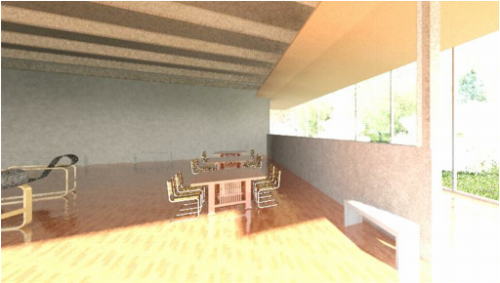To create a context for the Revit families, I constructed an interior space from my current studio project. I placed the Husser table family that I created in the room and set chairs from the Revit family library next to these. I used Sina Meier's bench family, which i think compliments the aesthetic of the building quite well, and I also used Joshua Kolberg's Aalto chair, which also has a modern aesthetic that matches the building.
Creating the context for the families also reminded me how much more streamlined and intuitive the building design tools are compared to the family creation tools, which don't seem quite as polished.
As we begin to delve into Revit, I am pleased to see that the user interface is very similar to the AutoCAD interface. The menus are also intuitive and easily navigated by first choosing a main category from the upper tabs, and then narrowing the categories down to a final specific command. Without prior knowledge of Revit, most commands that I am instructed to carry out can be found relatively easily. Revit will undoubtedly get more complex, however, as we explore aspects of the program that differ greatly from AutoCAD and Google Sketch-up.
Another aspect of Revit that has become apparent as we begin to explore it is how effective it is in streamlining the design process. It differs from AutoCAD and Google Sketch-up in the way that the plans, sections, and detail drawings are being created along with the three dimensional model of the structure. As the model is created, the floor plans are drawn up, and I only need to show where I want to cut a section or have a detail drawing to have it created.
Another way that this program streamlines the design process is due to that the three dimensional models are made up of actual structural parts. When you draw a wall or window, the program automatically knows the all the properties of that component, and this can be used later to gather structural, environmental, and other vital data about the structure.
One aspect of Revit that concerns me as far as its potential as a design tool is whether the component based design process will limit creativity due to constraints on what shapes can be created. Our instructor, however, told us about a tool to create abstract shapes that the structural parts can then be adapted to, and I am interested in experimenting with this aspect.

 RSS Feed
RSS Feed